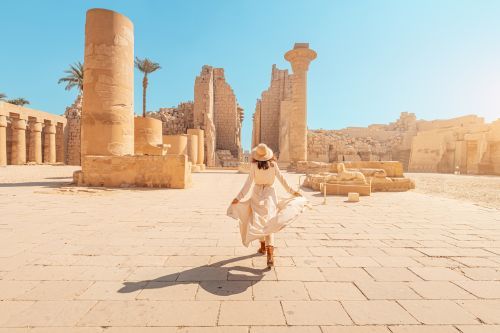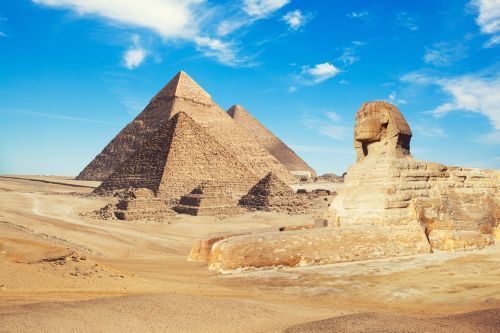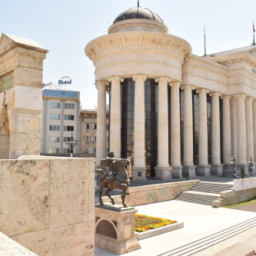

The country of mighty pharaohs, pyramids, the longest river in the world, and powerful gods with animal faces has undergone significant changes over thousands of years.
What has remained of the language used by the pharaohs? Do modern Egyptians write in hieroglyphs? Does the Egyptian language still exist? Let’s embark on a journey to North Africa to find out all the answers. Yallah!
Contents
Egyptian language, an extinct language
The Egyptian language was used by ancient civilization; it consolidated the society and facilitated the transmission of ideas, beliefs, and values that shaped Egyptian culture and history. The oldest relics of this extinct language from the Afroasiatic language family date back to 3250 BCE. The development of Egyptian can be divided into five phases: Old Egyptian, Middle Egyptian, Late Egyptian, Demotic, and Coptic.
Coptic language
The Coptic language is the final phase of the extinct Egyptian language. It was written with the Coptic alphabet, based on the Greek script with six additional characters from Demotic, the ancient Egyptian script. Coptic was primarily used by Christians in Egypt as a liturgical, scientific, and literary language.
With the arrival of the Arabs in Egypt, the language gradually lost its users. By the 17th/18th centuries, it remained present only in the liturgy of the Coptic Orthodox Church. Attempts to revive the Coptic language for everyday use in the 20th century were unsuccessful. Nowadays, no Coptic speakers are remaining.
Hieroglyphs
The Egyptian language used hieroglyphic, hieratic, demotic, and modified Greek scripts. Hieroglyphs, most commonly associated with Ancient Egypt, are pictograms that represent specific meanings. Some of them had phonetic values. It is estimated that the script consisted of about 7,000 hieroglyphs.
The Egyptians believed that writing was invented by the ibis god of knowledge, Thoth. That’s why they used the script as a way to communicate with gods.
Hieratic script
The hieratic script was used for writing sacred texts on papyrus. It appeared around 3000 BCE during the First Dynasty. It differed from hieroglyphs as it no longer had a pictorial nature. The symbols were often combined to express a broader idea.
Demotic script
The Demotic script was used in the times of the Twenty-sixth Dynasty of Egypt (from the 7th century BC). It was widely used for both literary and administrative documents, and later as well for scientific, literary, and religious texts. It is written using symbols that represent words or phrases, making it easier to write than other scripts such as hieroglyphics. The writing was horizontal from right to left. The Demotic extinct due to the raising popularity of the Greek alphabet. The last discovered Demotic-written texts were from 450 AD.
Ancient Egyptian literature
One of the most popular works in Ancient Egypt was the Book of the Dead, a collection of funerary texts intended to help achieve eternal life after death. The book contained prayers, magical formulas, and instructions for overcoming obstacles on the journey to life after death. Fragments of the Book of the Dead were often placed in tombs to accompany the deceased.
Another famous book in the ancient Egyptian language was Dispute between a man and his Ba. This philosophical literary text is written as a dialogue. The main character is engaging in a discussion with his soul about the value of life, death, and suffering.
Arabic language in Egypt
The official language of Egypt is Arabic. The Egyptian variety of the language is widely used in the nation. It is the native tongue of around 68% of the population (source: Egypt Time Travel). Its development has been marked by contacts with the Coptic, Italian, French, and Ottoman cultures. Influences of these languages can be easily traced in the vocabulary.
Would you like to translate different texts from all over the Arab world: Egypt, Saudi Arabia, and Oman? Our Arabic translation agency has experience working with every dialect. Contact us through a form on our website and we will get back to you shortly!
History of Arabic language in Egypt
The history of the Arabic language in Egypt dates back to the 7th century when the Arabs, led by Amr ibn al-As, invaded the region, bringing with them Islam and the Arabic language. The standard literary language of the Quran played a crucial role in shaping the country’s culture and history. Gradually, the Coptic language, which was used by the local Christian population, began to lose its users. By the XIX century, it was limited to a ritualistic role.
The golden age of Arabic learning in medieval Egypt brought many significant achievements in mathematics, medicine, astronomy, philosophy, and the human sciences. Scholars translated the most notable Greek, Roman, and Persian works into Arabic, adding their part to the development of Arabic science and philosophy.



Egyptian Arabic
Egyptian Arabic originated in Lower Egypt, in Cairo and its surroundings. Locally, the most used dialect in Egypt is called maṣri. Due to the popularity of Egyptian media and films, the variation is widely understood in the whole Arab world.
Egyptian Arabic has slightly different pronunciation than Modern Standard Arabic (MSA):
- The sound /q/ is often replaced by /g/. It can be noticed in the word qahwa (“coffee”) which is pronounced /gahwa/ in Egypt.
- The sound /j/ is replaced by /g/ in the Egyptian dialect. That is why the word yad (“hand”) sounds more like /gad/.
- The sound /k/ pronounced by young Egyptians resembles the English sound /tʃ/. The name of an animal, kalb (“dog”) will be articulated /tʃalb/.
The Egyptian grammar is a simplified version of MSA. The sentence typically follows the SVO (Subject + Verb + Object) word order, while in the literary language the VSO (Verb + Subject + Object) order prevails.
Many words from the Egyptian dialect are unique; you will not find them in the MSA. It is mainly due to foreign influences, especially from the Coptic language. The examples include bah (“flower”), batta (“duck”), and sett (“woman”). It is possible to trace loanwords from European languages—French and English—mainly in technology, science, and culture, e.g. dīkor (“decor”), tilīfūn (“telephone”) and bofeh (“buffet”).
Arabic literature in Egypt
Since the 7th century, following the Arab conquest of Egypt, Arabic culture began to develop dynamically in the region. The influence was visible in the literature. Papyrus was replaced by canvas, and Arabic calligraphy was adopted for writing texts.
One of the earliest novels written in Egyptian Arabic was the theological novel Theologus Autodidactus by Ibn al-Nafis. Many stories from the One Thousand and One Nights also can be traced back to tales passed on from generation to generation by medieval Egyptians.
The printing press arrived in Egypt with Napoleon at the end of the 18th century. Inspired by the invention, the ruler, Muhammad Ali, founded the Amiri Press. From that time, this printing house played a significant role in shaping Egyptian literature. It was there where the first Egyptian newspaper, Al-Waqa’i’ al-Misriyya (The Egyptian Affairs), was printed.
Among the most prominent figures in the 20th-century Egyptian literature, it is worth mentioning Taha Hussein and Naguib Mahfouz. Mahfouz was the first (and so far, the only) Egyptian to win the Nobel Prize in Literature.
Nubian languages in Egypt
Nubian languages are a group of African languages spoken in parts of the Nile valley, especially in southern Egypt and north-central Sudan. In the past, it was probably the main language of ancient Nubia.
In earlier times, Nubian languages used the Greek alphabets, alike Coptics. Contemporary writers use both the Arabic script, the Latin alphabet, or the medieval Old Nubian script. Currently, 3–4 million Nubians are living in Egypt; most of them preserve the traditions and language of their ancestors (source: Minority Rights).
Beja language in Egypt
The Beja language is an Afro-Asiatic Cushitic language spoken by the Beja people, who inhabit northeastern Sudan, south-eastern Egypt, and Eritrea. The number of speakers counts around 1.9 million people (source: Encyclopedia Britannica).
Beja has a rich vowel and consonant systems, using distinctive throat sounds. It is a fusional language, where various endings express grammatical cases, numbers, and tenses. The modern language contains many words of Arabic origin. Nowadays, either the Latin alphabet or Arabic script is used for writing Beja.
English language in Egypt
English is taught in Egyptian schools, used in international companies, and for communication with tourists. Many educated people can speak English fluently. Most road signs are written in both Arabic and English to facilitate navigation. In Giza, there is even an English-language newspaper, Daily News Egypt, published.
Are you in the process of recruiting new employees for completing your international team? Is the high proficiency in Arabic and English highly valuable to the company? Use Focus Audit Tool to test language knowledge. It is one of the quickest and most efficient ways to establish language level correctly.
نفسي اشوفك قريب! (nefsy ashofak!)
If Arabic is black magic for you, but you know basic English or French, it may be useful to refresh them before the journey. Language courses in our school are always taught by experienced lectors who will make you remember useful phrases and words. Break the language barrier and start speaking.















